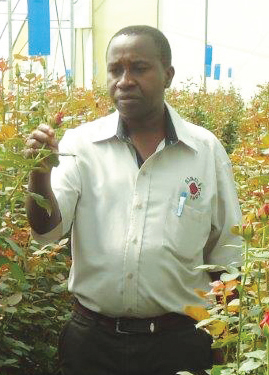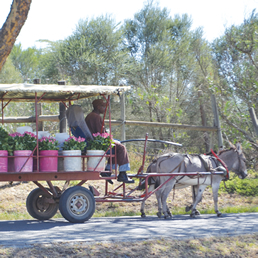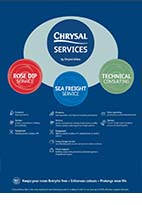Featured Past Articles
Who is Andrew Tubei? (Background-personal and as a grower)
 I am the production and Technical Manager of Maasai flowers, one of the units of Sian group of farms. I’m enterprising and multi skilled grower with more than 13 years in the production of roses, Zantedeschia/ Calla lily and summer flowers. I believe in working objectively and business first mind frame which in turn helps me to improve efficiency, effectiveness and productivity. I work in a challenging and dynamic position with a solid firm that recognizes individual growth and personal contribution to the realization of company objectives.
I am the production and Technical Manager of Maasai flowers, one of the units of Sian group of farms. I’m enterprising and multi skilled grower with more than 13 years in the production of roses, Zantedeschia/ Calla lily and summer flowers. I believe in working objectively and business first mind frame which in turn helps me to improve efficiency, effectiveness and productivity. I work in a challenging and dynamic position with a solid firm that recognizes individual growth and personal contribution to the realization of company objectives.
You have been growing and selling flowers for most of your professional life, if you would have to give your remarks about being a grower, what would they be?
The production of cut flowers is both capital and knowledge - intensive. Due to the extreme sensitivity of the product, professional management and constant vigilance is needed during all phases of growing, packaging and shipping. Because fresh cut- flowers do not undergo any processing between harvesting and sale, growers are essentially producing a finished product. Cut flowers sold in direct markets often retain the identity of the individual grower, and growers who can successfully differentiate their products can attain profit levels far in excess of other producers.
1 Master the Basics
 Highly successful growers make it a habit to always include the fundamentals of growing when dealing with crop issues. These fundamentals or “Basics” refer to 5 considerations when growing a crop:
Highly successful growers make it a habit to always include the fundamentals of growing when dealing with crop issues. These fundamentals or “Basics” refer to 5 considerations when growing a crop:
• Air exchange: all plant life depends on Oxygen and Carbon dioxide and cannot survive long without it.
• Water exchange: second most important in a plant’s survival
• Nutrient exchange: mastering the basics of plant nutrient uptake can determine a great crop from an average crop.
• Light exchange: essential for photosynthesis
• Temperature stability: for both air and soil, specific for each crop.
Mastering these basics involves a complete understanding of how and why they affect the crop at every stage, without this knowledge the grower is unable to determine what conditions and techniques are best when managing the crop. The successful grower when making changes makes it a habit to not override the plant basics and hinder the goal of a quality crop.
A weak Euro
Firming up Dollar
Failing Russia Market
Ecuadorian Flowers Flood Europe
Horticultural products exporters to the European Union have been hit by a weak euro as the world’s second largest reserve currency against the Kenya shilling.
The local unit has been steadily gaining strength against the euro since July last year in what analysts say will have an effect on earnings from exports to Europe. The euro last dropped to these levels in mid-2012 when in touched Sh103.
A weak euro means fewer shillings for each euro exchanged thus dealing a double blow to exporters to Europe, as they invoice their produce in euros but procure their inputs in dollars.
The dollar has, on the other hand, been firming up against the Kenya shilling piling pressure on an import-dependent economy as importers have to folk out more shillings for a dollar.
Delays in issuing permits have stalled the expansion
Horticultural farmers in Ethiopia want to expand their farms to remain competitive worldwide, but delays in issuing permits have stalled production. The Ethiopian Horticultural Producers Expoerters Association (EHPEA) has therefore written a letter to Prime Minister Hailemariam Desalegn, to look into this problem.
In order to meet the ever increasing market demand, local and foreign investors in Ethiopia are demanding to expand their farms, states EHPEA, but many farms in Oromia National Regional State have already requested to expand a couple of years ago but their requests have not yet been properly addressed.
“Hence, the foreign currency to be generated from the sector and potential job opportunities to be created were not achieved”, writes EHPEA, that also praises the Ethiopian government for its ‘unreserved and consequent efforts’ extended to the horticultural sector’ to make the country an important player in the world.
“Such a development has attracted many buyers and investors to the country creating a favourable image. These investors have capacitated their human resource, improved their quality of produce and became competitive in the world market”, the letter explains.
Meanwhile EHPEA has agreed with the Ethiopian Agricultural Transformation Agency (ATA) to collaborate on boosting the export of fruits and vegetables. Both parties agreed to capitalise EHPEA members’ export experience and ATA’s accumulated experience in value chain development as a positive combination.
Representatives of ATA in the Household Irrigation Project and Technical Expert in Value Chain Development (horticulture) clarified that their agency has an established program geared towards the development of the horticulture value chain in which key products have already been identified.
From the side of EHPEA it was stressed that some of their commercial member farms have an established market linkage. The current EHPEA project on the Ethio-Dutch Horticulture Development Program is also taken as a vital instrument to increase the export of fruits and vegetables. The agencies further agreed to combine their marketing strategies to identify key areas of development according to market requirements.
Floriculture is an old traditional production with roots in ancient times. Starting from the XVII century, famous authors have written technical books, which show the importance of this special branch of agriculture. During the last century, professionals have developed the production of exotic plants, which needs more and more sophisticated techniques to be produced. Today, cut flowers and pot plants production in the world represents 380,000 ha, of which a large part is produced in greenhouses, and a market of 60 billons euros.
Today Amiran Kenya have partnered with Tessenderlo Group Fertilisers to offer the industry Solucros®, a highly soluble form of potassium sulphate (K2SO4) also known as Sulphate of Potash (SOP) for fertigation systems which is the world most popular and premium quality low chlorine fertiliser. It combines the essential nutrients potassium and sulphur in an optimum form that is readily available to plants to supply a very high concentration of the nutrients.
Speaking on the importance of the product, Mr. Michel Marchand, Tessenderlo Group’s Technical Manager states that when Solucros®, is compared to other potassium sources such as MOP (muriate of potash) and NOP(nitrate of potash), SOP has a very low salinity index making it the preferred potash fertiliser in areas at risk from salinity. He adds to say these features make SOP the most effective fertiliser in many parts of the world as well as the most environmentally friendly.
Solucros®, plays these key roles:
1. Mineral nutrition Mineral nutrition depends on variety and the number of variables linked to cropping conditions. Nevertheless, some common parameters exist such as a pH from 5.5 to 7, a constant supply of water and elements, in an adequate ratio. 1:0.5:1 is usually considered as a basal ratio for a balanced fertilization.
Today, a large part of the cut flower production uses soilless cultivation and fertigation, which explains the popularity of soluble and liquid fertilizers. EC of the solution in the media should not generally exceed 3dS.m-1. Nitrogen is applied in nitrate and ammonium forms, respectively 75% and 25% usually. Potassium is an important element regarding quality and shelf life, sometime required in higher quantity compared to nitrogen. Calcium is essential as part of the cell membrane, playing a role in the rigidity of the stalks.
2. What source of Potassium? Sulphate of Potash (SOP) is more and more used as source of potash in cut flower production as well as for plant in pot. Indeed, potassium nitrate (NOP), which was the main form applied in the past, is more expensive, when potassium chloride (MOP) can be detrimental in a cash crop production and an intensive cropping system, where the risk of chloride accumulation is high. This is well demonstrated in an experiment on marigold, in which SOP and MOP are compared to control at 180 and 270 kg K2O/ha (see graph 1) .
.
Let us look at the producer’s requirement in floriculture: they need a constant production or a production at the same time per plot and the cut flowers should present a homogeneous size, nice colour and a good vase life. Regarding production and quality parameters, SOP shows better results compared to MOP and at least equivalent or better than NOP in recent experiments carried out in India in collaboration with the Horticultural College of Pune University.
Solucros® use in cut flower production Experiments carried out under drip irrigation shows the benefit of Solucros®, compared to NOP and MOP. Flowers fertigated with Solucros® have generally strongest stem, bigger flower diameter and a longer vase life (see graph 2, 3 and 4). New findings in potash fertilization show that potassium sulfate is an alternative to traditional potash sources in flower production, allowing a perfect management of the major element without any risk with chlorine accumulation. The benefit of chlorine free potash fertilizers on production and quality parameters is clearly established. On another hand, the potential of growth for cut flowers and pot plants in the world is important. Thanks to the benefits of potassium and sulphur on quality and production, SOP is becoming the best farmer investment in fertilizer management in floriculture. What are the ideal properties for a soluble SOP? The level of insolubles is critical since these particles can block fertigation systems. In general, a good quality soluble SOP should typically contain less than 0.05% insolubles. A product with more than 0.1% insolubles is generally regarded as bad. Products with more than 0.5% insolubles are often not a soluble grade at all but standard SOP powder.
Maximum solubility is also important as this reflects the concentration of nutrients in the solution. A good soluble grade should have solubility greater than a 12% (the maximum for SOP in pure water is around 13%). The solubility of poor quality grades is normally less than 11%.
Another factor to consider is pH. Generally speaking, acidic products are preferred since they help promote optimal pH around the root zone for maximum nutrient uptake. An acidic solution also tends to protect drippers from clogging. It is also true that acidic products tend to have better solubility than pH neutral materials. Speed of dissolution is of course another important factor for users of soluble SOP.
Solucros® is meeting all these quality criteria and explains is position as a world leader on soluble SOP market and for our Floriculture Industry a perfect product placement in the nutrition regime.
Amiran’s Head of the Agro-Division, Aviv Levi reveals that for plants to grow to their full potential there is need for farmers to invest in products that increase yield and boost growth of the crop. Levi states that as trade between Kenya and European countries expands, the floricultural sector has been challenged to grow more produce and still maintain the high international quality standards. This and more has been part of the reason why Amiran and Tessenderlo Group have come together to make farming a profitable and enjoyable experience for farmers.
Union fleurs and the kenya flower council welcome the EU’s timely efforts to fasttrack Kenya’s reinstatement on duty-free status for its exports to the EU market – on time for Valentine’s Day 2015, the flower industry’s peak sale season.
This week, the European Parliament and the Council have both confirmed that they do not object to the proposed European Commission Delegated Regulation issued on 14 November 2014 that re-inserts Kenya on the list of beneficiary countries in Annex I to Council Regulation (EC) No 1528/2007 – the so-called ‘EU Market Access Regulation’ (MAR). In so doing Kenya is now expected to be reinstated by end of the year to duty - free status for all flowers and floriculture products imported to the EU. This comes as a huge relief for Kenya’s floriculture sector and for all operators and businesses involved in the floriculture trade both in Kenya and in the EU, particularly in view of the approaching peak sale season on Valentine’s Day.
Kenya is the major provider of quality cut flowers to the EU market, with a total export value of 350 million EUR and a market share of about 40%. The floricultural industry has significantly contributed to economic, social and environmental development in Kenya and created job opportunities for close to 90,000 Kenyans employed directly and a further 1.5 million people employed in the ancillary service sectors.
Since 1 October 2014, flower exports from Kenya to the EU market have started attracting import duties between 5% and 8.5% under the EU GSP regime due to the delay in finalising an Economic Partnership Agreement (EPA) between the EU and the East African Community (EAC) member states. The additional cost associated with the duties has had to be absorbed by the floriculture sector in order to remain competitive in European markets and to safeguard jobs and the enormous capital investment in the industry.
Following the successful finalization and initialing of the EPA between the EU and EAC member states on 16 October 2014, all operators involved in the floriculture trade with Kenya have been anxiously awaiting the announcement of the reinstatement of a duty-free regime for all flower exports from Kenya to the EU market. The sector welcomed the Commission’s proposed Delegated Regulation re-inserting Kenya on the list of beneficiary countries in Annex I to Council Regulation (EC) No 1528/2007, made on 14 November 2014 – the so-called ‘EU Market Access Regulation’ (MAR).
The process of reinstatement was further accelerated through recognition by both the European Parliament and the Council of the crucial importance of the approaching Valentine’s Day peak flower sale season on the EU market that is central to the financial sustainability of the flower industry in Kenya. As a result the standard 2 month review period was successfully reduced to one month only.
The members of both Union Fleurs and the Kenya Flower Council therefore wish to express their most sincere thanks and gratitude to the Kenya Government, Ministry of Foreign Affairs and International Trade and their counterparts in the EAC partner countries for their tireless efforts to bring the EPA negotiations to a successful conclusion and to all the EU decisionmakers in the Commission, European Parliament and Council for completing the essential institutional processes in the most time-efficient manner thereby facilitating the early reinstatement of Kenya to a dutyfree status by the end of the year.
What now remains to be done is the formal publication in the EU Official Journal of the Commission Delegated Regulation that will effectively advise customs in the EU and operators that the duty free status of Kenya flower and floriculture imports to the EU has been reinstated. We expect this final formal step to be completed before 31 December 2014, meaning that Kenya can start the New Year with a renewed duty-free access to the EU market.
All parties are aware that there remain some essential steps to be taken by both the EU and the EAC member states to sign and ratify the EPA within the next two years to ensure that Kenya can confidently plan its long term trading relationship with the EU and expand the investment in the Kenyan floriculture sector. It is certainly our sincere hope that the spirit of cooperation within and between the EU and Kenya and its EAC partner countries that has resulted in a timely and successful conclusion of the MAR process will be maintained to achieve finalization of the EPA ratification process in a timely manner, and before 2016.
Oserian Development Company a member of the Kenya Flower Council won the most Innovative African Producer for 2014 award in recognition of their sustainable developments which underpin and complement Sainsbury’s 20 by 20 Sustainability Targets. The award was presented by Mr John Owles during a courtesy visit by Sainsbury’s to Oserian farm.
Oserian currently stands at the industry forefront as one of the largest multi-crop farm in Kenya appreciated not only for being the most technologically advanced flower farm in the country but also as a global leader in sustainable and ethical practice. Oserian’s eco-friendly approach embraces alternative energy sources and green chemistry in order to reduce to a bare minimum the carbon footprint across the entire farm.
The farm has put in place multiple water conservation measures that include the use of hydroponics, construction of wetlands and detailed water usage by crop. Oserian’s “green by name green by nature” policy is anchored in the greenhouse heating project and Integrated Pest Management, which has enabled significant reduction of pesticides use.
In addition to pioneering the floricultural industry, Oserian has always had a vision to improve the livelihoods of the local communities. A recent initiative, through a joint venture with Stokman Rozen Kenya Ltd, has been to supply farmers with clean tissue culture banana plants and seed potatoes as well as training on good soil husbandry. Such projects go a long way in assisting local farmers maximise yields from their land by adopting modern farming techniques.
John Owles, Sainsbury’s Project Manager for East Africa said “This award is a clear sign that Sainsbury’s is serious about quality and provenance and are aimed at forging closer relationships with the supermarket’s suppliers in Africa”.
“Sainsbury’s has been instrumental in supporting Oserian’s initiatives as part of its efforts to sustainably grow the flower industry in Kenya”, he added. Sainsbury’s is the third largest chain of supermarkets in the United Kingdom with a 16.4% share of the UK supermarket sector.
As global agriculture continues to embrace sustainable farming practices, Oserian’s significant investment places her in prime position for the future development of the floriculture industry. Further, Oserian’s innovations will add impetus to the Kenyan agricultural sector towards achieving Vision 2030 goals.


